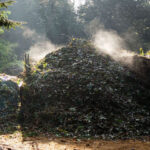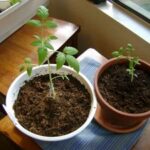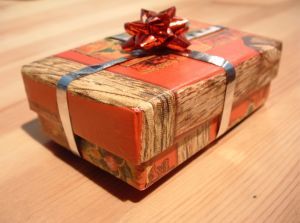Composting can be a great addition to any gardener’s home or non-gardening home. Many people are turning to composting in their backyards for many reason including wanting to reduce landfill waste, fertilizer for their gardens, save money on fertilizer, or to know exactly what is going into their fertilizer.
Composting bins can be expensive, hard to come by, or not so easy to build. There are few different ways to help with this. You can forget the bin entirely and do a compost heap. But for some that’s not a choice. Especially if you live in a city, in a apartment, etc. Sometimes you just don’t like the looks of a pile of compost in your backyard. That’s understandable. So, what’s a person to do when the above are not an option? Simple, a trash can. Not only is it cheap, easy to find, but it doesn’t take nothing more then a plastic garbage bin or two, a lid (preferably one that locks onto the bin), and a electric screw driver to set it up. Also maybe few bricks to sit the bin on. But that’s not necessary. I’ll go into more details about that in a little bit.
The set up of the bin is fairly simple. The idea bin size is between 32 gallons to 50 gallons. Anything bigger may make it hard when it comes time to turn the compost. If you’re using an old bin wash it out thoroughly along with the lid. Better safe then sorry. Take the bin and put it upside down. Take the electric screwdriver and drill about ½ inch holes all over the sides and bottom. Wear safety glasses or goggles. Plastic in the eye hurts and can be very dangerous (even blinding!). You may also want to put some holes in the lid. But it depends on a few factors. If it rains a lot in your area you may not want too. It could cause your compost to be to wet. If you live in an area like I do were it doesn’t rain a whole lot through out the year but when it does, it’s like floodgates has opened. You may also not want to put holes in the lid. It’ll be too much water at once for the compost. But it’s entirely up to you.
To elevate or not to elevate is another choice you’ll need to make. This is were the bricks come in. If you sit your compost bin up on bricks it’ll help for better drainage and better air circulation. But if you let it sit directly on the ground it allows the compost have access to organisms and worms. Either way it’s a matter of choice. Personally since I don’t have any spare bricks lying around I just let it sit directly on the ground.
Now that you have your compost bin set up it is time to add things to the compost. When it comes to composting there are two categories. There is the greens which is nitrogen rich materials and there is the browns that are carbon materials. You’ll want to try to keep it 50/50 between the two. It’s ok if it’s not exactly 50/50 but as close as possible is idea. But what is consider as a green or a brown exactly? Here’s a small list to help get you started.
Browns;
Small pieces of Wood (must be untreated!)
Straw
Bark
Vegetable stalks
Fruit Waste
Peanut shells
Dry leaves
Sawdust (must be untreated!)
Stems & twigs
Greens;
Coffee grounds (you can even toss the paper filter in)
Tea grounds (you can toss in the paper bag and cotton string in just remove the staple carefully)
Food waste
Garden waste
Grass clippings
Seaweed
Vegetable scraps
Weeds (avoid weeds that have gone to seed)
Things to avoid at all cost;
Chemicals – Lawn/garden chemicals (herbicides/pesticides) can survive the composting process and remain in the final product. Chemicals do not belong in composting, period!
Pressure treated and other chemically treated lumber – It’s treated with chemicals and can be toxic to compost and plants.
Coal ash – Contains high enough amounts of iron and sulfur to damage plants.
Colored paper – Some paper with color (including newsprint) contains heavy metals and other toxic materials. Do not add to compost no matter what!
Dog/cat litter – Can contain different disease organisms and can make compost toxic and dangerous to handle.
Inorganic materials – Glass, foil, plastics, and metals never break down.
Diseased plants – The diseased organisms can be spread when the compost is used for other plants. It takes extreme heat to destroy the organisms that really can’t be obtained in this kind of composting. If in doubt about whether or not a plant is diseased then it’s best not to add it to the pile.
Meat, bones, fish, fat, dairy – It’ll make your compost stink and attract animals. Something you don’t want.
If you are in doubt about whether or not you should add something to the compost bin it’s better to be safe and not add it. The health of yourself, family, compost, and garden is more important. There are two ways of putting all this into your compost. If you have enough of greens and browns you can do the layer method. It’s easy and simple. Have a layer of brown, then a layer of green, back and forth. But sometimes you don’t have enough of either or you don’t want to spend a whole lot of time on it. In that case you can just toss everything in, more mixed up the better. And then you just keep tossing stuff in as you get it.
With composting you’ll want to keep it moist, but not soggy. It’s moist enough when it has the feel of a rung out sponge. When you see it getting dry you can easily just take a hose and water it down a little at a time until it reaches the right amount of moisture. Another thing you can do is if you have any fruit juice that’s not good anymore you can just pour it into the compost but make sure it’s made from real fruit.
At some point you may want to turn it. The idea is the more you turn it the sooner you’ll have finished compost. At most you want to turn it is about once a week. Anymore and you may end up cooling it down. Or if you want don’t bother with turning it at all. With this method it’ll take longer for it to finish but it is less work. If you are going to turn it there are few different methods. One is to tip the bin onto it’s side with the lid securely on and rolling it around. Down fall of this method is it can be heavy and harder to manvourer around. Another method is to shovel the compost into another bin. Prepare the bin the same as you did the first one. Take a pitchfork (or a shovel but a pitchfork seems to work better) and fork the compost into the new bin. Some find it easier if they tip the bin filled with compost over so they can easily fork out the contents compared to the bin standing straight up. Test it out to see which you prefer.
Finished compost is dark and crumbly like loose soil. It also has a earthy smell to it. You may need to shift it to separate the finish product from the bits that’s still decomposing. Let it cure out in the open for at least two weeks after it’s finished composting. Then enjoy using compost that you created yourself.




